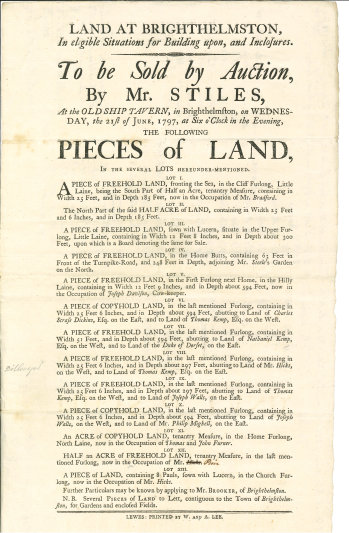Andrew Bennett, Brighton and Hove Archivist, writes: The majority of these documents relate to the rental, sale and development of land in the tenantry laines of Brighton. The tenantry laines were fields surrounding the town which were sold off piecemeal to developers during the early 19th century: the layout of the strips within those fields determines the contemporary street pattern of this area of Brighton. The documents comprise maps of land fit for development, annotated sale particulars and, most interesting of all, diagrams of buildings and proposed layouts of William Street in east central Brighton.
The papers seem to form part of the archive of William Dillwyn (1743-1824) of Higham Lodge, Walthamstow in Essex, a Pennsylvanian Quaker who returned to Britain in 1777, settled at Walthamstow and was to become a leading abolitionist, and his son Lewis Weston Dillwyn (1778-1855), naturalist and porcelain manufacturer. Both men were important figures in Brighton's development at this period. William Dillwyn bought the Old Ship Hotel in 1821 but although his name appears throughout our catalogue on property deeds, none contain the level of detail shown in these documents. Although we hold a large archive of building plans for Brighton, this series pre-dates them by a decade. This area was one of the first to be demolished as part of slum clearance in the 1890s so it is a part of Brighton about which comparatively little is known.
We do not hold any comparable papers that illustrate in so much detail the processes carried out by landowners, both local and from further afield, to develop land for building. This group has the added interest of representing the investment in Brighton's development of wealth acquired through manufacturing, in this instance the Swansea Porcelain Factory.
The lot also included the unrelated deeds of 4 and 5 Cannon Place, Brighton, 1805-1909, which have been listed as AMS 7408/2
William Dillwyn's diaries recording his departure from Pennsylvania for England, tours of parts of England and south Wales, his religious, political and business activities, the anti-slavery committee, and family business, 1774-1775, 1777, 1781-1790, are held at the National Library of Wales.

![Sketch plan for a new street in Brighton [William Street], 1807. Courtesy of ESBHRO. Sketch plan for a new street in Brighton [William Street], 1807](/sites/default/files/styles/large/public/20221111145059974%202.png?itok=p_t2FP8m)